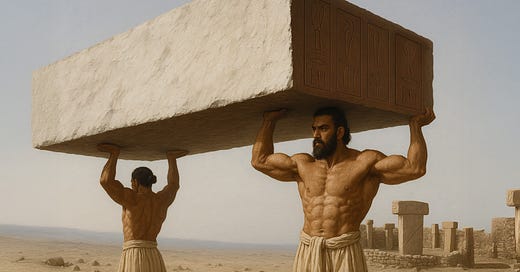Göbekli Tepe & the Giants: Are Ancient Megastructures Proof of Fallen Angel Technology?
Rick Renner
Excerpted from Fallen Angels, Giants, Monsters & the World Before the Flood.
Of all the races of giants mentioned after the Flood, a group called the Anakim is referred to most throughout the Old Testament.
These giants were the descendants of Anak, the son of a man named Arba (see Joshua 15:13). Arba was a descendant of Canaan, the son of Ham, which made Arba the great-grandson of Noah. Joshua 14:15 (NKJV) says, “…Arba was the greatest man among the Anakim….” In fact, he was so powerful at one time, the city of Kirjath-Arba was named after him (it later became known as the renowned city of Hebron).
Anakim giants made such an impression on the Israelites that they became the yardstick or benchmark that other giants were measured against. The following verses are provided to show how well-known the Anakim were and how frequently they, and their physical sizes, are mentioned in Scripture. You will also notice that scattered among these passages are the names of other groups of giants that we will look at more closely in the pages to come. But notice the frequency with which the dreaded Anakim are mentioned in the book of Deuteronomy:
Whither shall we go up? our brethren have discouraged our heart, saying, The people is greater and taller than we; the cities are great and walled up to heaven; and moreover we have seen the sons of the Anakims there.
— Deuteronomy 1:28
The Emims dwelt therein in times past, a people great, and many, and tall, as the Anakims; which also were accounted giants, as the Anakims; but the Moabites called them Emims.
—Deuteronomy 2:10,11
That [the land of the Ammonites] also was accounted a land of giants: giants dwelt therein in old time; and the Ammonites call them Zamzummims; a people great, and many, and tall, as the Anakims; but the Lord destroyed them before them; and they succeeded them, and dwelt in their stead.
—Deuteronomy 2:20,21
Hear, O Israel: Thou art to pass over Jordan this day, to go in to possess nations greater and mightier than thyself, cities great and fenced up to heaven, a people great and tall, the children of the Anakims, whom thou knowest, and of whom thou hast heard say, Who can stand before the children of Anak!
Understand therefore this day, that the Lord thy God is he which goeth over before thee; as a consuming fire he shall destroy them, and he shall bring them down before thy face: so shalt thou drive them out, and destroy them quickly, as the Lord hath said unto thee.
— Deuteronomy 9:1-3
In these four passages, Moses addressed the nation of Israel and recalled three of the groups of giants they’d encountered since the Exodus from Egypt. Along with mentioning the Emim and Zamzummim, Moses cited the Anakim six times and essentially stated that even though they were great in size, strength, and number, God had enabled the children of Israel to decimate them.
We also find that Joshua, Moses’ successor, referred to the Anakims. After the Israelites had cut off the Anakim giants from the cities of Hebron, Debir, Anab, and all the mountains of Judah, the Bible says:
There was none of the Anakims left in the land of the children of Israel: only in Gaza, in Gath, and in Ashdod, there remained.
— Joshua 11:22
The Old Testament narrative goes on to tell of a moment when Joshua divided the conquered land and assigned it to the various tribes of Israel. In that moment, Caleb suddenly spoke up and said:
Now therefore give me this mountain, whereof the Lord spake in that day; for thou heardest in that day how the Anakims were there, and that the cities were great and fenced: if so be the Lord will be with me, then I shall be able to drive them out, as the Lord said.
— Joshua 14:12
Indeed, the Anakim giants (or sons of Anak) were well-known by the children of Israel. As noted, when the 12 spies went in to spy out the Promised Land — one of which was Caleb — it was the descendants of Anak that they saw in numerous cities. As part of their negative, fearful report, 10 of the spies said:
Nevertheless the people be strong that dwell in the land, and the cities are walled, and very great: and moreover we saw the children of Anak there.
The Amalekites dwell in the land of the south: and the Hittites, and the Jebusites, and the Amorites, dwell in the mountains: and the Canaanites dwell by the sea, and by the coast of Jordan.
— Numbers 13:28,29
According to these two verses, the children of Anak — the Anakim giants — were made up of subset groups. And these groups were the Amalekites in the land of the south; the Hittites, Jebusites, and Amorites that dwelled in the mountains; and the Canaanites that dwelled by the coast of Jordan.
Giants Actually Proliferated After the Flood
A careful study of the Old Testament reveals that there were numerous tribes of giants living throughout the Promised Land (also known as the land of Canaan). These tribes of giants included:
Amalekites
Amorites
Avim
Canaanites
Emim
Girgashites
Hittites
Hivites
Horim
Jebusites
Kadmonites
Kenites
Kenizzites
Perizzites
Zamzummim
In Genesis 14:5 we find the Rephaim, Emim, and Zuzim (a variant of the name Zamzummim) giants were involved in a battle that took place during the time of Abraham between two groups of kings. This verse says:
Keep reading with a 7-day free trial
Subscribe to Destiny Image to keep reading this post and get 7 days of free access to the full post archives.




